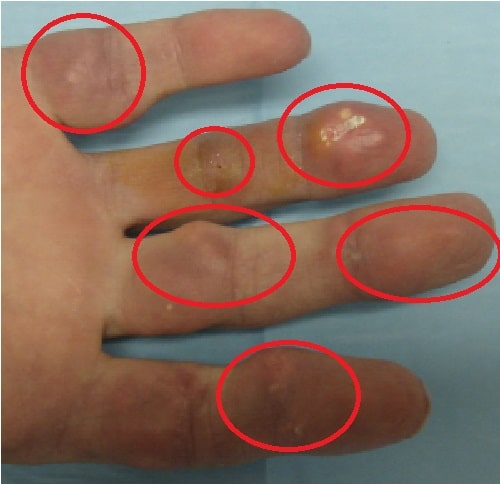Calcinosis cutis is a condition where calcium salt crystals accumulate in the skin. As a result, calcium deposits appear in the form of hard, insoluble lumps, with varying shapes and sizes.
This is a rare condition that has many different causes. Often, calcinosis cutis has no symptoms other than the appearance of a lump. However, in some cases, it can be very painful.
Symptoms of Calcinosis Cutis
Calcinosis cutis usually looks like a lump on the skin. It can come on slowly over time and have no other symptoms or it can come on suddenly and become severe. The lumps can be skin-colored or white and hard or soft. Some may ooze a white fluid and be very painful.
Depending on the type, these lumps can appear in various places on the body, such as:
- Day
- Accumulation
- Kneeling
- Lower arm
- Butt
- Under the lupus wound
- Around the joints
- Face
- Profiteer
- Eyelid
Although a lump may have no symptoms, sometimes other problems can occur, including:
- Difficulty walking or moving
- Disability
- Skin ulcer
- Muscle or tendon stiffness
- Joint deformity
- Painful
Causes of Calcinosis Cutis
Calcinosis cutis is rare but has various causes, depending on the subtype, namely:
1. Dystrophic Calcification
This occurs when tissue damage causes protein phosphate to be released by damaged cells, which then calcifies, forming calcium salts. Tissue damage can occur due to infection, tumors, acne, or connective tissue diseases such as lupus, systemic sclerosis, or dermatomyositis.
2. Metastatic Calcification
When calcium phosphate is abnormally high, it produces calcium salts that form lumps on the skin. The causes of abnormal calcium and phosphate levels are:
- Chronic kidney failure (the most common cause).
- Too much vitamin D.
- Hyperparathyroidism.
- Sarcoidosis.
- Milk-alkali syndrome (too much calcium from food or antacids).
- Bone diseases, such as Paget’s disease.
3. Idiopathic Calcification
Unlike the two types of calcinosis cutis, idiopathic calcification occurs without underlying tissue damage. In fact, there are no abnormal levels of calcium or phosphorus.
Idiopathic means the cause is unknown. This subtype is divided into three types, namely:
- Familial nodules, which usually appear in adolescents or children.
- Subepidermal nodules, which appear just beneath the skin.
- Nodules on the scrotum.
4. Iatrogenic Calcification
Iatrogenic causes of calcification are medical procedures that inadvertently cause calcium salt deposits as a side effect. Some procedures that can cause this are:
- Administration of solutions containing calcium and phosphate.
- Prolonged contact with saturated calcium chloride electrode paste during electroencephalography or electromyography.
- Intravenous calcium gluconate, calcium chloride, and para-aminosalicylic acid in the treatment of tuberculosis.
- Heel spurs in newborns.
5. Calciphylaxis
The cause of calciphylaxis is still uncertain because it is very rare. However, some factors that can trigger it are:
Risk Factors for Calcinosis Cutis
There are many factors that can increase the risk of calcinosis cutis, namely:
- Infection.
- Disorders of calcium metabolism that cause hypercalcemia (too much calcium in the blood).
- A genetic or autoimmune disorder that affects the skeletal system and connective tissue.
- Persistent inflammation.
Diagnosis of Calcinosis of the Skin
Knowing the type of calcinosis cutis you have is important in determining the right treatment. Your doctor will examine you and take your medical history and ask you questions about your symptoms.
The doctor will likely perform several laboratory tests to determine the underlying cause, such as:
- Blood tests to see if calcium and phosphate levels are too high. This is to check for signs of lupus and possible tumors and to rule out abnormal parathyroid and vitamin D levels.
- Metabolic tests to see if there are any kidney problems.
- X-rays, CT scans, or bone scans (scintigraphy) to see the extent of the calcification.
- Biopsy.
- Other special tests to check for dermatomyositis (an inflammatory disease) and milk-alkali syndrome.
A new technology being developed to aid in diagnosis is advanced vibrational spectroscopy. This diagnostic technique uses Fourier transform infrared (FT-IR) or Raman spectroscopy analysis. It quickly identifies the chemical composition of calcinosis cutis lesions. It can also predict the progression of the disease.
Treatment of Calcinosis Cutis
Treatment for calcinosis cutis depends on the underlying disease or cause. Here are some of the treatment options available:
1. Medicines
Various medications can be tried to treat lumps, but their success depends on each individual. For small lumps, medications that may help include:
- Warfarin
- Ceftriaxone
- Imunoglobulin intravena (IVIG)
Meanwhile, for larger lumps, medications that can help are:
- Diltiazem
- Bisphosphonate
- Probenecid
- Aluminum hydroxide
2. Operation
If the lump is painful, frequently infected, or interferes with activities, your doctor may recommend surgery. However, lumps can recur after surgery. So, surgery should start with a small part of the lump.
3. Other Treatments
A new treatment option is hematopoietic stem cell transplantation (HSCT), which replaces a person’s own blood-producing cells. This has been used as a treatment for several autoimmune diseases.
Additionally, laser therapy and shock wave lithotripsy (ultrasound therapy to break up kidney stones) may also be considered.
Complications of Calcinosis Cutis
Calcinosis cutis can cause complications such as:
- Joint problems
- Disabled
- Swelling
- Infection
- Skin ulcer
- Painful
Prevention of Calcinosis Cutis
You may be able to prevent calcium deposits by monitoring your health and getting regular checkups. If you are 65 or older, your doctor may recommend a blood test to track your calcium levels.
If you are under 65 and have heart or kidney problems, you are more likely to have calcium deposits. In these cases, your doctor may recommend a calcification test.
Additionally, certain medications can affect calcium levels in the body. So, ask your doctor to better understand the effects of prescribed medications on calcium levels in the body.
Another effort you can make is to stop smoking. Because, this habit can trigger calcium buildup, as well as increased calcification in the heart and arteries.

